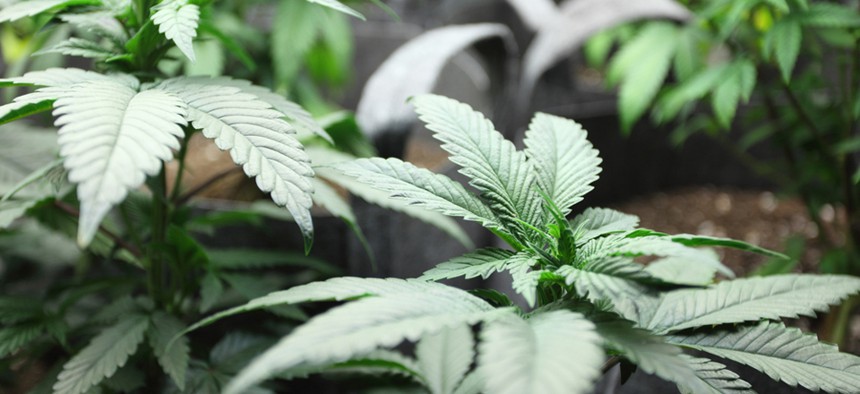The DEA Still Thinks Marijuana is as Dangerous as Heroin
The drug is now legal for medial or recreational use in many states, but the feds still classify cannabis as a schedule 1 substance
Marijuana is now legal for medical or recreational use in nearly half of US states, even though the US government still officially puts the drug in the same category as heroin, LSD and ecstasy.
At the federal level, the US Drug Enforcement Administration (DEA) classifies cannabis as a schedule 1 substance, the most dangerous class under the Controlled Substances Act, with “a high potential for abuse and potentially severe psychological and/or physical dependence.”
Many scientists say there is little basis to put marijuana in that category, and the DEA’s stance that marijuana has no medicinal use has been widely rebuked in recent years. But marijuana’s dangers and uses have not been definitively established within the scientific community, and that’s partly because of the very limited research done on the subject. Paradoxically, the drug’s schedule 1 status has hamstrung exactly the marijuana research necessary to change its classification.
The schedule 1 status also puts states looking to go their own way on marijuana policy in a legal gray area. In theory, this classification means that any US state seeking to regulate rather than prosecute marijuana distribution is technically violating federal law. But the Department of Justice’s Aug 2013 Cole memo made it clear that the federal government would leave it to states to enforce their own marijuana policy.
And this leaves those in the growing legal marijuana industry in a quandary, since, banks have refused (paywall) to open accounts for marijuana suppliers and distributors, even in states where it is legal, because of the drug’s schedule 1 status.
The DEA has the authority to re-schedule the drug. But such a move would put the agency into a direct confrontation with Congress, which in its current makeup is unlikely to endorse the move. President Barack Obama has said he considers marijuana no worse than alcohol when abused, but also that he will leave it to Congress to determine whether to downgrade its status from schedule 1.
Roadblocks to scientific study
While marijuana’s schedule 1 classification does not prohibit scientists’ from conducting research on its effects, there are several impediments to effective study and plenty of red tape to cut through. For one, the DEA restricts just how much marijuana can go to research. Additionally, researchers must get their proposed studies approved by the DEA and two more governmental agencies—the Department of Health and Human Services (HHS) and the Food and Drug Administration (FDA).
The task is further complicated by the fact that the National Institute on Drug Abuse (NIDA) has a monopoly over the entire marijuana supply available to researchers, says Rick Doblin, a marijuana researcher and executive director of the Multidisciplinary Association for Psychedelic Studies (MAPS), a US non-profit committed to developing psychedelics and marijuana into prescription medicines.
The monopoly, Doblin explains, extends only to marijuana and not to any other schedule 1 drugs. This, he says, proves that both the DEA and NIDA “are not basing these decisions on science, but rather on politics.”
He cites his own experience trying to obtain marijuana for study from the government. In 1990, he said, and a group of researchers requested marijuana plants from NIDA for an approved study. Next year, 25 years later, his lab will finally receive the plants.
Lack of research funding
The dearth of authoritative marijuana research is partly due to a lack of funding from the country’s two major government health agencies, the National Institutes of Health and the National Science Foundation, who both have been reluctant to go against the DEA’s position, says John Hudak, a fellow at the Brookings Institute and an expert on marijuana policy.
Universities and research centers, he explains, are also wary of using federal dollars for marijuana research “because the government has substantive punitive powers to close them down,” Hudak tells Quartz. “It creates a chilling effect for scholars and medical professionals.”
One way around this could be for a private university to solicit non-governmental funding for research. Billionaire George Soros, for example, has donated at least $200 million since 1994 to drug policy reform and research in the US. Most of that funding, however, has gone to policy-oriented non-profit organizations, such as the Drug Policy Alliance, not to scientific research.
Universities have been reluctant to accept even private money for this work, Hudak says, because with other research being funded in the same facility, the government could make the case that the marijuana studies would likely take place in a lab is, at least partially, federally funded—and could then move to shut it down.
Political calculus
For now, politics seems to be acting to suppress marijuana research, not to drive it. But of course, that could change in the longer term, if opinion within Congress starts to more closely mirror that of the majority of the country. A little over half of Americans already support marijuana legalization—a growing group that skews young.
“The DEA will likely act on re-scheduling marijuana when it no longer fears congressional repercussions,” says Hudak. “Until then, what you’re going to continue to see is an America where marijuana is legal and protected in some places and illegal and prosecuted in others. To overseas observers, this policy will continue to appear slightly absurd.”
(Image via Peter Kim/Shutterstock.com)



